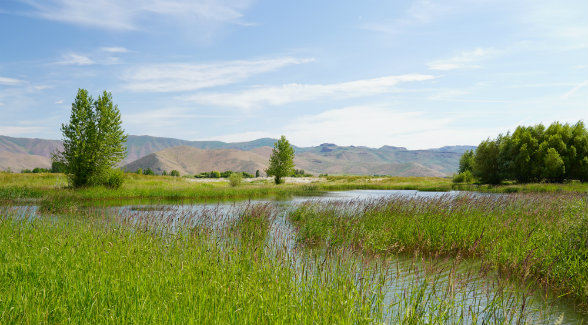Warning: Array to string conversion in /home/domains/dev.landreport.com/public/wp-content/plugins/elementor/core/dynamic-tags/manager.php on line 64





Warning: Undefined array key "separator_height" in /home/domains/dev.landreport.com/public/wp-content/plugins/jet-tricks/includes/addons/jet-unfold-widget.php on line 942

Sparsely populated since the dawn of time, the American West is struggling to sustain burgeoning growth and increasing demands on its resources. One group offering answers? Private landowners.
By KEN MIRR
There’s a new phenomenon out West, one that, as a board member of the Western Landowners Alliance, a conservation attorney, and a broker, I’m excited to be a part of. It revolves around private landowners sustainably managing their water resources and their lands for the greater good and for profit. The greater good includes numerous beneficiaries: city dwellers, agricultural producers, flora and fauna, the environment — the list is endless. The profit element centers on public policies and incentives that support and encourage voluntary stewardship of critical resources.
In this article, I’m going to focus on two standout examples: Idaho’s Silver Spring Ranch, which flows into the Columbia River system, and The Cottonwood in Wyoming, which contains the headwaters of the Green River, a key tributary of the Colorado River. Both are current listings of mine, and working with their owners and managers has been one of the true rewards of being a broker.
COLUMBIA RIVER WATERSHED

TOM O’GARA OF O’GARA COACH was originally a fan of Aspen, a Woody Creek regular back in the heyday of Hunter S. Thompson, Don Henley, and John Oates. He migrated north to Sun Valley and bought his breathtaking ranch in 1989.
With 3,422 deeded acres, SILVER SPRING RANCH is one of the last remaining examples of a high-desert cold-spring ecosystem in the Western US. In addition to farming and ranching components, the ranch also sustains one of the West’s most significant fisheries, the Silver Creek Watershed, by providing 60 to 75 percent of the flows into Silver Creek’s unique aquatic ecosystem.
Credit Mother Nature with the lion’s share of these flows, courtesy of Big Wood River diversions as well as natural springs on the ranch. But Tom and his ranch manager, Brandon Jones, have established a water management system that not only enhances these resources but creates new ones.
The Big Wood River and Silver Creek share a complex interconnected water system. The relationship between the surface and groundwater systems is such that any stress or change on one system affects the other.
To maximize groundwater recharge and surface outflows, the ranch maximizes surface water inflow, minimizes irrigation from groundwater, and minimizes consumptive water use. This is accomplished through careful management that includes crop choices, harvesting times, soil moisture management, and a suite of other factors that optimize water use and availability.
A state-of-the-art monitoring system captures discrete data about water management and its effect on streams and groundwater. The system also helps balance ecological benefits with running a viable ranching and farming operation.
Over the years, grazing cattle destroyed many of the streams, springs, and spring heads on the ranch. The effects of this practice combined with direct runoff raised the water temperature of Silver Creek itself. Through significant improvements to the water delivery system, including the ditches, canals, and headgates, as well as reclamation and restoration of the springs and spring heads, the ranch has single-handedly given new life to the springs and lowered the water temperature of the springs and Silver Creek.
The ranch also obtained wastewater rights to build recharge ponds that not only cleanse and cool the wastewater, but they have brought up the levels of the underlying aquifer.
The ranch’s beef program has moved to organic certification and installed water efficient nozzles on pivots. Now, the ranch offers spectacular habitat diversity including shrubland, riparian forest, and wetlands, all of which provide cover and food for over a hundred bird species, high densities of stream insects, and large trout in the streams.
A final endeavor worth mentioning is the creation of a wetland at Silver Spring Ranch funded in part by Ducks Unlimited. This infrastructure was designed to capture additional surface water, recharge the water table, and, of course, enhance waterfowl habitat.
COLORADO RIVER WATERSHED

FRED BOTUR IS ONE OF THE MOST fascinating individuals I have ever had the good fortune to know. He fled his native Czechoslovakia during a Communist crackdown in 1948 and later became a fixture in New York City as the proprietor of Tennisport, a 16-court tennis club on the East River. In the middle of his many adventures, he acquired one of the most ecologically significant ranches in the West in 1989.
Wyoming’s COTTONWOOD RANCH is an 85 square-mile contiguous block of deeded and leased land in the Upper Green River Valley. It boasts some of the most important wildlife in the Greater Yellowstone Ecosystem.
In addition to healthy populations of moose, elk, pronghorn antelope, mule deer, sage grouse, raptors, and burrowing owls, The Cottonwood is home to 65 species of concern in Wyoming. The ranch is a migration corridor and provides crucial habitat during the winter months as well as year round for many of these species.
In 2014, the declining levels of Lake Mead and Lake Powell led the Upper Colorado River Commission, the Bureau of Reclamation, and four water providers to set up a program to test water conservation strategies that could be part of a drought contingency plan. The goal was to demonstrate the viability of a cooperative and voluntary program that would reduce the likelihood of falling water levels in the two massive reservoirs. The program encouraged farmers and ranchers to voluntarily and temporarily forgo the use of their water resources by not irrigating their fields and pastures. Instead, their waters would replenish the Colorado.
With 40 miles of rivers and streams, The Cottonwood is blessed with extensive riverine and riparian corridors. Because of these significant water resources — 6,310 acres of irrigated fields and 76.9 cfs of water — the Boturs were invited to participate in this unprecedented pilot program.
Trout Unlimited assisted with this program, which ultimately provided cooler water to streams, improved the overall health of fisheries, and delivered more water to parched residents of Nevada, Arizona, and California.
Not only were the Boturs compensated for their voluntary participation, but their award was one of the largest given to a landowner in Wyoming. It goes without saying that this cash flow was a welcome addition to the revenues generated by the ranching and outfitting operations run by Fred’s son, Freddie. While the program has since expired, it appears that similar programs will be introduced to tackle this problem.
Working in concert with federal and state agencies and national and local land trusts, the Boturs have placed conservation easements on portions of the ranch and received funding to install pipelines, replace antiquated headgates, and build wildlife-friendly fencing. They also utilize progressive grazing practices on the ranch itself and on surrounding BLM ground. The ranch is working with the BLM on a grazing project that benefits wildlife as well as cattle. These practices have resulted in healthier land and soil, and have enabled willow coverage to expand along Cottonwood Creek. The result is a more stable water table in a critical riparian zone.
CONCLUSION

AN ESTIMATED 80 PERCENT of wildlife utilize privately owned lands. Why such a large percentage? Because Western settlement patterns, past and present, have almost always followed water.
This is one of the principal reasons that private landowners own some of the most ecologically diverse lands out West, and it also demonstrates the need to establish incentives to promote the private conservation of water resources.
The majority of fertile valley bottoms and accessible water resources are privately managed. The way Westerners look after and monetize these resources impacts everything from agricultural productivity to urban viability, healthy landscapes, and, as I just mentioned, to fish and wildlife.
More often than not, water availability, quality, and usage will be essential components of developing any effective long-term solution. Landowners will play a critical role in developing answers to all of these challenges — and more — in the decades to come.
RELATED ARTICLES
Farmland Partners to Purchase Eight Row-Crop Farms
Farmland Partners Inc. (NYSE: FPI) will acquire 15,042 acres of farmland in North Carolina, South …
Cromwell Island
Like the cold, clear waters of Flathead Lake, mystique surrounds Cromwell Island. It overlooks the …
Legalization of Hemp Leads to Legal Nightmares
In Georgia, consumption of hemp and hemp products is legal, but the consumption of cannabidoil …
Elk Creek Ranch Acquires Seven Lakes
For those who are passionate about outdoor pursuits, the next great adventure can’t come soon enough.





